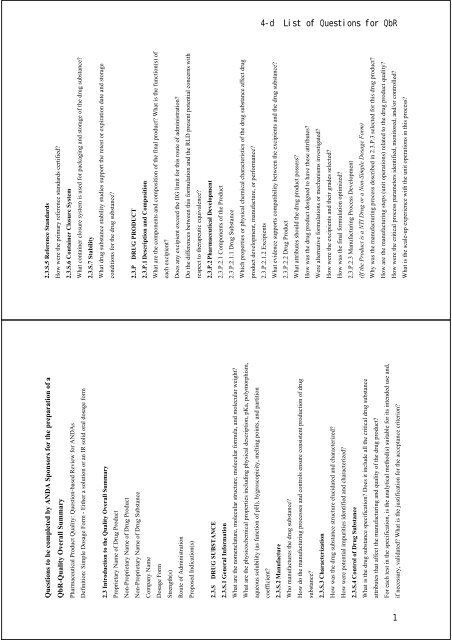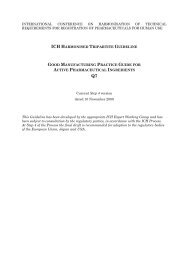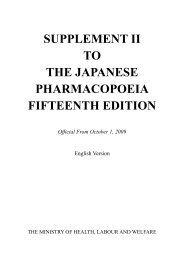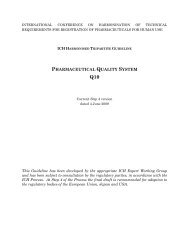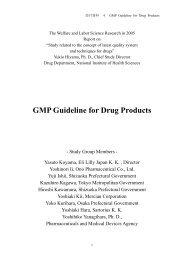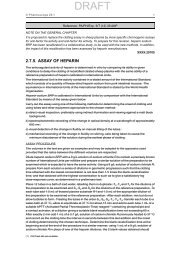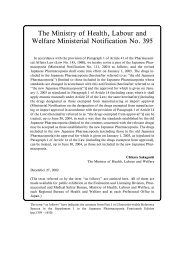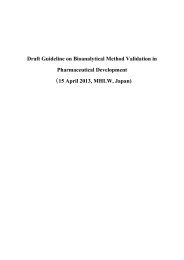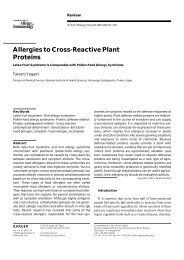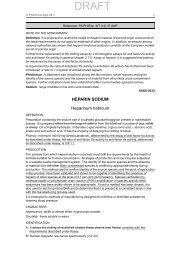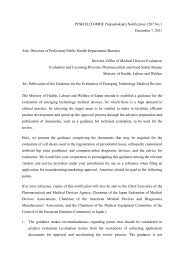OPS/OC/ONDQA/OGD - NIHS
OPS/OC/ONDQA/OGD - NIHS
OPS/OC/ONDQA/OGD - NIHS
You also want an ePaper? Increase the reach of your titles
YUMPU automatically turns print PDFs into web optimized ePapers that Google loves.
Questions to be completed by ANDA Sponsors for the preparation of a<br />
QbR-Quality Overall Summary<br />
Pharmaceutical Product Quality: Question-based Review for ANDAs<br />
Definition: Simple Dosage Form - Either a solution or an IR solid oral dosage form<br />
2.3 Introduction to the Quality Overall Summary<br />
Proprietary Name of Drug Product<br />
Non-Proprietary Name of Drug Product<br />
Non-Proprietary Name of Drug Substance<br />
Company Name<br />
Dosage Form<br />
Strength(s)<br />
Route of Administration<br />
Proposed Indication(s)<br />
2.3.S DRUG SUBSTANCE<br />
2.3.S.1 General Information<br />
What are the nomenclature, molecular structure, molecular formula, and molecular weight<br />
What are the physicochemical properties including physical description, pKa, polymorphism,<br />
aqueous solubility (as function of pH), hygroscopicity, melting points, and partition<br />
coefficient<br />
2.3.S.2 Manufacture<br />
Who manufactures the drug substance<br />
How do the manufacturing processes and controls ensure consistent production of drug<br />
substance<br />
2.3.S.3 Characterization<br />
How was the drug substance structure elucidated and characterized<br />
How were potential impurities identified and characterized<br />
2.3.S.4 Control of Drug Substance<br />
What is the drug substance specification Does it include all the critical drug substance<br />
attributes that affect the manufacturing and quality of the drug product<br />
For each test in the specification, is the analytical method(s) suitable for its intended use and,<br />
if necessary, validated What is the justification for the acceptance criterion<br />
2.3.S.5 Reference Standards<br />
How were the primary reference standards certified<br />
2.3.S.6 Container Closure System<br />
What container closure system is used for packaging and storage of the drug substance<br />
2.3.S.7 Stability<br />
What drug substance stability studies support the retest or expiration date and storage<br />
conditions for the drug substance<br />
2.3.P DRUG PRODUCT<br />
2.3.P.1 Description and Composition<br />
What are the components and composition of the final product What is the function(s) of<br />
each excipient<br />
Does any excipient exceed the IIG limit for this route of administration<br />
Do the differences between this formulation and the RLD present potential concerns with<br />
respect to therapeutic equivalence<br />
2.3.P.2 Pharmaceutical Development<br />
2.3.P.2.1 Components of the Product<br />
2.3.P.2.1.1 Drug Substance<br />
Which properties or physical chemical characteristics of the drug substance affect drug<br />
product development, manufacture, or performance<br />
2.3.P.2.1.2 Excipients<br />
What evidence supports compatibility between the excipients and the drug substance<br />
2.3.P.2.2 Drug Product<br />
What attributes should the drug product possess<br />
How was the drug product designed to have these attributes<br />
Were alternative formulations or mechanisms investigated<br />
How were the excipients and their grades selected<br />
How was the final formulation optimized<br />
2.3.P.2.3 Manufacturing Process Development<br />
(If the Product is a NTI Drug or a Non-Simple Dosage Form)<br />
Why was the manufacturing process described in 2.3.P.3 selected for this drug product<br />
How are the manufacturing steps (unit operations) related to the drug product quality<br />
How were the critical process parameters identified, monitored, and/or controlled<br />
What is the scale-up experience with the unit operations in this process<br />
添 付 資 料 4-d List of Questions for QbR<br />
1


